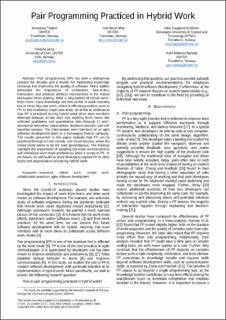| dc.contributor.author | Tkalich, Anastasiia | |
| dc.contributor.author | Moe, Nils Brede | |
| dc.contributor.author | Andersen, Nina Haugland | |
| dc.contributor.author | Stray, Viktoria | |
| dc.contributor.author | Barbala, Astri Moksnes | |
| dc.date.accessioned | 2024-01-17T13:17:24Z | |
| dc.date.available | 2024-01-17T13:17:24Z | |
| dc.date.created | 2024-01-16T16:41:55Z | |
| dc.date.issued | 2023 | |
| dc.identifier.issn | 1949-3770 | |
| dc.identifier.uri | https://hdl.handle.net/11250/3112203 | |
| dc.description.abstract | Pair programming (PP) has been a widespread practice for decades and is known for facilitating knowledge exchange and improving the quality of software. Many agilists advocated the importance of collocation, face-to-face interaction, and physical artifacts incorporated in the shared workspace when pairing. After a long period of forced work-from-home, many knowledge workers prefer to work remotely two or three days per week, which is affecting practices such as PP. In this revelatory single-case study, we aimed to understand how PP is practiced during hybrid work when team members alternate between on-site days and working from home. We collected qualitative and quantitative data through 11 semi-structured interviews, observations, feedback sessions, and self-reported surveys. The interviewees were members of an agile software development team in a Norwegian fintech company. The results presented in this paper indicate that PP can be practiced through on-site, remote, and mixed sessions, where the mixed mode seems to be the least advantageous. The findings highlight the importance of adapting the work environment to suit individual work mode preferences when it comes to PP. In the future, we will build on these findings to explore PP in other teams and organizations practicing hybrid work. | en_US |
| dc.language.iso | eng | en_US |
| dc.publisher | IEEE | en_US |
| dc.rights | Navngivelse 4.0 Internasjonal | * |
| dc.rights.uri | http://creativecommons.org/licenses/by/4.0/deed.no | * |
| dc.title | Pair Programming Practiced in Hybrid Work | en_US |
| dc.title.alternative | Pair Programming Practiced in Hybrid Work | en_US |
| dc.type | Peer reviewed | en_US |
| dc.type | Journal article | en_US |
| dc.description.version | acceptedVersion | en_US |
| dc.source.journal | International Symposium on Empirical Software Engineering and Measurement | en_US |
| dc.identifier.doi | 10.1109/ESEM56168.2023.10304797 | |
| dc.identifier.cristin | 2228053 | |
| cristin.ispublished | true | |
| cristin.fulltext | postprint | |
| cristin.qualitycode | 1 | |

